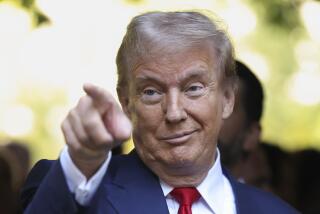Op-Ed: The Chinese view: Ten truths about U.S.-China trade
The Trump administration is fighting a trade war with the whole world, and especially with China. The president has slapped tariffs on Chinese goods, railing about the U.S.-China trade deficit. Last year, China exported goods and services worth roughly $500 billion to the U.S., and the U.S. sent back exports worth $130 billion. The president calls that $370-billion deficit thievery, but most economists don’t see its harm to America.
The American people need to hear the truth about U.S.-China trade, instead of Trump’s charges of bad faith. Despite what the president says, trade between our nations is free and fair, and these 10 points explain why.
1. Although China, as a developing country, has higher tariffs on U.S. goods than the U.S. does on Chinese goods, its tariffs are still lower than those of many other developing countries, including India. Since China’s accession to the World Trade Organization in 2001, it has consistently lowered its trade barriers. China has been the fastest growing market for U.S. exports, and U.S. exporters are not stupid: They know a good deal when they see it. According to China’s Ministry of Commerce data published last year, 56% of U.S. soybeans, 26% of Boeing airplanes and 17% of American-made automobiles are sold in China.
2. As for goods coming into the U.S., American importers are not stupid either. No one is forcing them to buy Chinese goods. Inexpensive Chinese imports have helped the U.S. middle class, which has experienced slow income growth for years, to buy more with the same income.
3. It isn’t Chinese barriers but U.S. export controls that limit our economic exchange. China’s trade advantage lies in its cheaper labor costs, and the United States’ advantage lies in capital and land. China exports labor-intensive products to the U.S. , the U.S. exports technology products and agricultural products to China. However, U.S. export policy is stricter than Europe’s (especially Germany’s) and Japan’s, determining what and how much can be exported. Without export prohibitions on 20 high-tech products such as aircraft and aircraft engines, navigation systems, lasers and fiber optics, the U.S.-China deficit would decrease.
4. Trade deficit numbers can be deceiving. Take the Apple iPhone. When they arrive in the U.S. from China where they are assembled, their high cost adds significantly to the trade imbalance in China’s favor. But Chinese workers and factories only receive 5% of the value of an iPhone (mainly labor costs), while Apple’s design, brand and marketing account for nearly 60% of its value. China doesn’t even provide parts for the iPhone; those come from the global supply chain and the benefit goes to the suppliers, not to China. By one calculation, an iPhone’s estimated “factory cost” — $240 — exaggerates the value of China’s exports to the U.S. because the Chinese keep less than $9 per phone.
5. When American protectionists talk about the trade deficit with China, they deliberately ignore the U.S. surplus in “service trade” — such sectors as travel, education, banking, insurance and royalty payments. According to Chinese statistics, in 2017 that imbalance was as high as $54.1 billion, and it has risen steeply for a decade.
6. Another thing protectionists deliberately ignore is that the sales of U.S. companies in China have surpassed $500 billion. These firms are making huge profits from the fast-growing Chinese market, and their success adds to the export of U.S. components and intellectual property rights to China.
7. As for intellectual property, Trump constantly accuses China of stealing U.S. technology and knocking off its goods. Although China established intellectual property protections late — in the 1990s — those laws are working. In 2017, China’s external payment of intellectual property fees reached $28.6 billion, 15 times more than when it joined WTO in 2001. U.S. intellectual property owners are the biggest beneficiaries.
8. Accusing Chinese firms of forced technology transfers is another outdated charge. No laws or regulations compel such transfers; joint ventures are based on deal-by-deal negotiations and some U.S. companies are willing to transfer technology for Chinese market access. General Motors’ and Ford’s joint ventures, for example, have made them two of the largest automobile manufacturers in China.
Enter the Fray: First takes on the news of the minute from L.A. Times Opinion »
9. President Trump wants to stop “Made in China 2025,” the state-subsidized plan to modernize Chinese industries, and he charges China with “state capitalism.” However, Chinese subsidies are not out of line with WTO regulations, and they are available to foreign-funded enterprises too. And the United States engages in similar protectionism: Subsidies and defense spending nurtured the internet, semiconductors, nuclear power plants and military-civilian space technology.
10. China’s trade practices are generally in compliance with WTO rules. Like the U.S., China is subject to a biennial WTO review. Since 2001, China has been accused 40 times and the U.S. 80 times in WTO disputes.When judgments go against China, it corrects its course. The United States has obeyed the WTO much less often.
China doesn’t want to fight Trump’s escalating trade war, but it will defend itself. At the same time, it is reaching out to other foreign investors to counterbalance U.S. actions. America may lose investment opportunities if the Trump administration persists. Worse, the president’s actions recall the 1930s, when Congress passed the protectionist Smoot-Hawley Tariff Act. The result was a worldwide trade war, a currency war and finally World War II. The American people should remember that history, and oppose Trump’s trade war on China.
Wang Yong is a professor at the School of International Studies at Peking University and a non-resident senior fellow at Center for China and Globalization, a private think tank in Beijing.
Follow the Opinion section on Twitter @latimesopinionand Facebook
More to Read
A cure for the common opinion
Get thought-provoking perspectives with our weekly newsletter.
You may occasionally receive promotional content from the Los Angeles Times.










